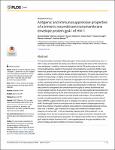Antigenic and immunosuppressive properties of a trimeric recombinant transmembrane envelope protein gp41 of HIV-1
Mühle, Michael
Lehmann, Melissa
Hoffmann, Kerstin
Stern, Daniel
Kroniger, Tobias
Luttmann, Werner
Denner, Joachim
The transmembrane envelope (TM) protein gp41 of the human immunodeficiency virus—1 (HIV-1) plays an important role during virus infection inducing the fusion of the viral and cellular membranes. In addition, there are indications that the TM protein plays a role in the immunopathogenesis leading to the acquired immunodeficiency syndrome (AIDS). Inactivated virus particles and recombinant gp41 have been reported to inhibit lymphocyte proliferation, as well as to alter cytokine release and gene expression. The same was shown for a peptide corresponding to a highly conserved domain of all retroviral TM proteins, the immunosuppressive domain. Due to its propensity to aggregate and to be expressed at low levels, studies comprising authentic gp41 produced in eukaryotic cells are extremely rare. Here we describe the production of a secreted, soluble recombinant gp41 in 293 cells. The antigen was purified to homogeneity and characterised thoroughly by various biochemical and immunological methods. It was shown that the protein was glycosylated and assembled into trimers. Binding studies by ELISA and surface plasmon resonance using conformation-specific monoclonal antibodies implied a six-helix bundle conformation. The low binding of broadly neutralising antibodies (bnAb) directed against the membrane proximal external region (MPER) suggested that this gp41 is probably not suited as vaccine to induce such bnAb. Purified gp41 bound to monocytes and to a lesser extent to lymphocytes and triggered the production of specific cytokines when added to normal peripheral blood mononuclear cells. In addition, gp41 expressed on target cells inhibited the antigen-specific response of murine CD8+ T cells by drastically impairing their IFNγ production. To our knowledge, this is the first comprehensive analysis of a gp41 produced in eukaryotic cells including its immunosuppressive properties. Our data provide another line of evidence that gp41 might be directly involved in HIV-1 immunopathogenesis through modulation of the cytokine release and active inhibition of immune responses.
No license information

